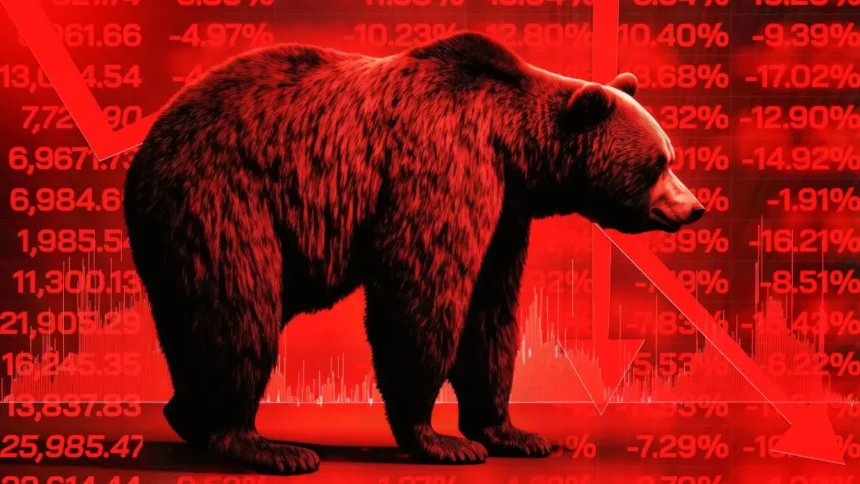Stock Market Crash Today: The 30-share BSE index ‘Sensex’ fell 1,235.08 points, or 1.60 per cent, to 75,838.36, led by losses in heavyweights like Reliance Industries and ICICI Bank. During the day, the BSE benchmark slumped 1,431.57 points, or 1.85 per cent, to a low of 75,641.87.
The Indian stock market witnessed a bloodbath today as the Sensex nosedived 1,235 points, marking its steepest fall in seven months. The Nifty index, too, settled below the critical 23,050 level, sending shockwaves across the trading community. This significant decline comes amid mounting global and domestic uncertainties, leaving investors grappling with losses. Here’s a detailed analysis of what caused today’s market crash and its broader implications.
Sensex Hits Seven-Month Low
The benchmark 30-share BSE Sensex plunged by 1,235.08 points, or 1.60%, to close at 75,838.36. Intraday, the index touched a low of 75,641.87, losing as much as 1,431.57 points (1.85%). Heavyweights like Reliance Industries, ICICI Bank, and State Bank of India bore the brunt of the sell-off, dragging the market to its knees. Meanwhile, the broader Nifty index failed to hold key support levels, slipping below 23,050 to settle at a seven-month low.
Key Factors Behind the Market Collapse
1. Profit-Booking in Heavyweights
One of the primary reasons for today’s market carnage was intense profit-booking in top-weighted stocks.
- Reliance Industries, the bellwether of the Indian stock market, saw its shares tumble by 2.5%.
- Banking majors like ICICI Bank and State Bank of India plunged up to 3%.
- HDFC Bank also reported a marginal decline of 0.8%.
These sharp corrections in heavyweight stocks triggered widespread panic among investors.
2. Disappointing Q3 Results
The lackluster performance of several key companies in the third quarter further dampened investor sentiment.
- Food delivery giant Zomato saw its stock price crash by a staggering 11%, wiping out 57% of its value during the quarter.
- Electronics manufacturer Dixon Technologies took a severe hit, with its shares sliding 14%.
The underwhelming Q3 earnings raised concerns over high valuations and the sustainability of growth in the near term.
3. Donald Trump’s Trade Policies
Global trade tensions escalated after former US President Donald Trump announced hefty tariffs on neighboring countries during his inauguration day speech.
- A 25% tariff on imports from Mexico and Canada sent shockwaves through global markets.
- Continued tariffs on China added to concerns about a potential slowdown in global trade.
The ripple effect of these protectionist measures had a direct bearing on Indian technology stocks, which are highly reliant on exports.
4. Pre-Budget Nervousness
With the Union Budget 2025 around the corner, investors adopted a cautious stance. The upcoming budget is expected to focus heavily on rural development and infrastructure spending while maintaining fiscal prudence. However, uncertainty over potential tax reforms and government borrowing plans kept traders on edge.
5. Foreign Capital Outflows
Foreign portfolio investors (FPIs) continued to offload Indian equities, intensifying the market’s downward spiral.
- January alone witnessed massive FPI outflows worth ₹51,000 crores.
- Rising US bond yields and a strengthening dollar made emerging markets like India less attractive for foreign investors.
Persistent FPI selling exerted significant pressure on both equity and currency markets.
Broader Implications of the Market Crash
1. Impact on Retail Investors
Today’s sell-off has left retail investors in dismay, with many portfolios taking a significant hit. The sharp decline in heavyweight stocks amplified losses, especially for those heavily invested in large-cap funds.
2. Weakness in Key Sectors
The sell-off was broad-based, with all major sectors ending in the red. Banking, IT, and energy stocks were among the worst hit, signaling underlying weakness across the market spectrum.
3. Global Market Spillover
The turbulence in the Indian stock market reflects broader global trends. Escalating trade tensions, coupled with concerns over a potential global economic slowdown, have unnerved investors worldwide.
What Lies Ahead?
The road ahead for the Indian stock market remains uncertain, with several key events on the horizon:
- Union Budget 2025: All eyes are now on the government’s budgetary announcements. Policies aimed at boosting consumption and investment could provide the much-needed respite for markets.
- Global Trade Developments: Any resolution or escalation in global trade disputes will play a crucial role in shaping investor sentiment.
- Foreign Investment Trends: A reversal in FPI flows could help stabilize the market, but that hinges on global macroeconomic factors.
Conclusion
Today’s stock market crash underscores the volatility and uncertainty that continue to plague global and domestic markets. While the immediate triggers were profit-booking, disappointing earnings, and global trade tensions, the underlying factors point to broader economic concerns. Investors are advised to adopt a cautious approach, focusing on fundamentals and diversification to navigate these turbulent times.










